Technical and Economic Evaluation for Off-Grid Hybrid Renewable Energy System Using Novel Bonobo Optimizer
Abstract
:1. Introduction
- ▪
- A novel BO algorithm was applied for the first time in this research to find the optimal design of the proposed off-grid HRES based on minimizing the annualized system cost and enhancing the power system reliability level.
- ▪
- Technical and economic evaluation were attained for the proposed off-grid HRES that includes PV, WT, diesel, and batteries to electrify an urban region in northern Saudi Arabia, namely, Al Sulaymaniyah.
- ▪
- To validate the performance soundness and credibility, the BO algorithm was compared to other four metaheuristic algorithms, namely, BBBC [47], GA [35], crow search [38], and the butterfly optimization algorithm (BOA) [49] in terms of optimal and worst solutions captured, mean, standard deviation (STDEV), convergence rate, and oscillations around steady state.
- ▪
- The simulation results revealed the supremacy performance of the BO algorithm compared to the other four metaheuristic algorithms. It attained the optimal design of the HRES with the minimum ASC (USD 149,977.2), quick convergence time, and fewer oscillations, followed by BOA (USD 150,236.4). The BBBC and GA algorithms failed to capture the global solution and had high STDEV, high oscillations, and high convergence time.
2. Description of the Proposed Off-Grid Hybrid Renewable Energy System
2.1. Modeling of PV Generation Source
2.2. Modeling of the WT Genertation System
2.3. Modeling of the Battery Bank as a Storage System
2.4. Modeling of the Diesel Generator
3. Problem Formulation: Objectives and Constraints
4. Application of Bonobo Optimizer Technique for HRES Optimal Sizing
4.1. Promiscuous and Restrictive Mating Approach
4.2. Consortship and Extra-Group Mating Strategies
5. Simulation Results and Discussion
6. Conclusions
Author Contributions
Funding
Acknowledgments
Conflicts of Interest
References
- Eltamaly, A.M.; Farh, H.M.H.; Al Saud, M.S. Impact of PSO reinitialization on the accuracy of dynamic global maximum power detection of variant partially shaded PV systems. Sustainability 2019, 11, 2091. [Google Scholar] [CrossRef] [Green Version]
- Alturki, F.A.; Al-Shamma’a, A.A.; Farh, H.M.H. Simulations and dSPACE Real-Time Implementation of Photovoltaic Global Maximum Power Extraction under Partial Shading. Sustainability 2020, 12, 3652. [Google Scholar] [CrossRef]
- Gao, K.; Wang, T.; Han, C.; Xie, J.; Ma, Y.; Peng, R. A Review of Optimization of Microgrid Operation. Energies 2021, 14, 2842. [Google Scholar] [CrossRef]
- Lian, J.; Zhang, Y.; Ma, C.; Yang, Y.; Chaima, E. A review on recent sizing methodologies of hybrid renewable energy systems. Energy Convers. Manag. 2019, 199, 112027. [Google Scholar] [CrossRef]
- Acuna, L.G.; Padilla, R.V.; Mercado, A.S. Measuring reliability of hybrid photovoltaic-wind energy systems: A new indicator. Renew. Energy 2017, 106, 68–77. [Google Scholar] [CrossRef]
- Gong, X.; Dong, F.; Mohamed, M.A.; Abdalla, O.M.; Ali, Z.M. A secured energy management architecture for smart hybrid microgrids considering PEM-fuel cell and electric vehicles. IEEE Access 2020, 8, 47807–47823. [Google Scholar] [CrossRef]
- Alnowibet, K.; Annuk, A.; Dampage, U.; Mohamed, M.A. Effective Energy Management via False Data Detection Scheme for the Interconnected Smart Energy Hub–Microgrid System under Stochastic Framework. Sustainability 2021, 13, 11836. [Google Scholar] [CrossRef]
- Belmili, H.; Haddadi, M.; Bacha, S.; Almi, M.F.; Bendib, B. Sizing stand-alone photovoltaic–wind hybrid system: Techno-economic analysis and optimization. Renew. Sustain. Energy Rev. 2014, 30, 821–832. [Google Scholar] [CrossRef]
- Zhao, X.; Wang, C.; Su, J.; Wang, J. Research and application based on the swarm intelligence algorithm and artificial intelligence for wind farm decision system. Renew. Energy 2019, 134, 681–697. [Google Scholar] [CrossRef]
- Chen, H.-C. Optimum capacity determination of stand-alone hybrid generation system considering cost and reliability. Appl. Energy 2013, 103, 155–164. [Google Scholar] [CrossRef]
- Shayeghi, H.; Hashemi, Y. Application of fuzzy decision-making based on INSGA-II to designing PV–wind hybrid system. Eng. Appl. Artif. Intell. 2015, 45, 1–17. [Google Scholar] [CrossRef]
- Zhang, Y.; Ma, C.; Lian, J.; Pang, X.; Qiao, Y.; Chaima, E. Optimal photovoltaic capacity of large-scale hydro-photovoltaic complementary systems considering electricity delivery demand and reservoir characteristics. Energy Convers. Manag. 2019, 195, 597–608. [Google Scholar] [CrossRef]
- Delgado-Antillón, C.; Domínguez-Navarro, J. Probabilistic siting and sizing of energy storage systems in distribution power systems based on the islanding feature. Electr. Power Syst. Res. 2018, 155, 225–235. [Google Scholar] [CrossRef]
- Menshsari, A.; Ghiamy, M.; Mousavi, M.M.; Bagal, H. Optimal design of hybrid water-wind-solar system based on hydrogen storage and evaluation of reliability index of system using ant colony algorithm. Int. Res. J. Appl. Basic Sci. 2013, 4, 3582–3600. [Google Scholar]
- Mohamed, A.F.; Elarini, M.M.; Othman, A.M. A new technique based on Artificial Bee Colony Algorithm for optimal sizing of stand-alone photovoltaic system. J. Adv. Res. 2014, 5, 397–408. [Google Scholar] [CrossRef] [Green Version]
- Maleki, A.; Askarzadeh, A. Optimal sizing of a PV/wind/diesel system with battery storage for electrification to an off-grid remote region: A case study of Rafsanjan, Iran. Sustain. Energy Technol. Assess. 2014, 7, 147–153. [Google Scholar] [CrossRef]
- Sanajaoba, S.; Fernandez, E. Maiden application of Cuckoo Search algorithm for optimal sizing of a remote hybrid renewable energy System. Renew. Energy 2016, 96, 1–10. [Google Scholar] [CrossRef]
- Berrueta, A.; Heck, M.; Jantsch, M.; Ursúa, A.; Sanchis, P. Combined dynamic programming and region-elimination technique algorithm for optimal sizing and management of lithium-ion batteries for photovoltaic plants. Appl. Energy 2018, 228, 1–11. [Google Scholar] [CrossRef]
- Zhou, W.; Lou, C.; Li, Z.; Lu, L.; Yang, H. Current status of research on optimum sizing of stand-alone hybrid solar–wind power generation systems. Appl. Energy 2010, 87, 380–389. [Google Scholar] [CrossRef]
- Farh, H.M.; Al-Shaalan, A.M.; Eltamaly, A.M.; Al-Shamma’A, A.A. A Novel Crow Search Algorithm Auto-Drive PSO for Optimal Allocation and Sizing of Renewable Distributed Generation. IEEE Access 2020, 8, 27807–27820. [Google Scholar] [CrossRef]
- Veilleux, G.; Potisat, T.; Pezim, D.; Ribback, C.; Ling, J.; Krysztofiński, A.; Ahmed, A.; Papenheim, J.; Pineda, A.M.; Sembian, S. Techno-economic analysis of microgrid projects for rural electrification: A systematic approach to the redesign of Koh Jik off-grid case study. Energy Sustain. Dev. 2020, 54, 1–13. [Google Scholar] [CrossRef]
- Odou, O.D.T.; Bhandari, R.; Adamou, R. Hybrid off-grid renewable power system for sustainable rural electrification in Benin. Renew. Energy 2020, 145, 1266–1279. [Google Scholar] [CrossRef]
- Amirkhalili, S.; Zahedi, A. Techno-economic analysis of a stand-alone hybrid wind/fuel cell microgrid system: A case study in Kouhin region in Qazvin. Fuel Cells 2018, 18, 551–560. [Google Scholar] [CrossRef]
- Luna-Rubio, R.; Trejo-Perea, M.; Vargas-Vázquez, D.; Ríos-Moreno, G. Optimal sizing of renewable hybrids energy systems: A review of methodologies. Sol. Energy 2012, 86, 1077–1088. [Google Scholar] [CrossRef]
- Jakhrani, A.Q.; Othman, A.-K.; Rigit, A.R.H.; Samo, S.R.; Kamboh, S.A. A novel analytical model for optimal sizing of standalone photovoltaic systems. Energy 2012, 46, 675–682. [Google Scholar] [CrossRef]
- Hung, D.Q.; Mithulananthan, N.; Bansal, R. Analytical strategies for renewable distributed generation integration considering energy loss minimization. Appl. Energy 2013, 105, 75–85. [Google Scholar] [CrossRef]
- Sanjel, N.; Baral, B.; Acharya, M.; Gautam, S. Analytical modelling for optimized selection between renewable energy systems and the conventional grid expansion. J. Phys. Conf. Ser. 2019, 1266, 012014. [Google Scholar] [CrossRef]
- Sinha, S.; Chandel, S. Review of recent trends in optimization techniques for solar photovoltaic–wind based hybrid energy systems. Renew. Sustain. Energy Rev. 2015, 50, 755–769. [Google Scholar] [CrossRef]
- Markvart, T. Sizing of hybrid photovoltaic-wind energy systems. Sol. Energy 1996, 57, 277–281. [Google Scholar] [CrossRef]
- Clúa, J.G.G.; Mantz, R.J.; De Battista, H. Optimal sizing of a grid-assisted wind-hydrogen system. Energy Convers. Manag. 2018, 166, 402–408. [Google Scholar] [CrossRef]
- Upadhyay, S.; Sharma, M. A review on configurations, control and sizing methodologies of hybrid energy systems. Renew. Sustain. Energy Rev. 2014, 38, 47–63. [Google Scholar] [CrossRef]
- Cabral, C.V.T.; Oliveira Filho, D.; Diniz, A.S.A.C.; Martins, J.H.; Toledo, O.M.; Lauro de Vilhena, B. A stochastic method for stand-alone photovoltaic system sizing. Sol. Energy 2010, 84, 1628–1636. [Google Scholar] [CrossRef]
- Khatib, T.; Ibrahim, I.A.; Mohamed, A. A review on sizing methodologies of photovoltaic array and storage battery in a standalone photovoltaic system. Energy Convers. Manag. 2016, 120, 430–448. [Google Scholar] [CrossRef]
- Giallanza, A.; Porretto, M.; Puma, G.L.; Marannano, G. A sizing approach for stand-alone hybrid photovoltaic-wind-battery systems: A Sicilian case study. J. Clean. Prod. 2018, 199, 817–830. [Google Scholar] [CrossRef]
- Rullo, P.; Braccia, L.; Luppi, P.; Zumoffen, D.; Feroldi, D. Integration of sizing and energy management based on economic predictive control for standalone hybrid renewable energy systems. Renew. Energy 2019, 140, 436–451. [Google Scholar] [CrossRef]
- Mahmoudimehr, J.; Shabani, M. Optimal design of hybrid photovoltaic-hydroelectric standalone energy system for north and south of Iran. Renew. Energy 2018, 115, 238–251. [Google Scholar] [CrossRef]
- Portero, U.; Velázquez, S.; Carta, J.A. Sizing of a wind-hydro system using a reversible hydraulic facility with seawater. A case study in the Canary Islands. Energy Convers. Manag. 2015, 106, 1251–1263. [Google Scholar] [CrossRef]
- Elbaz, A.; Güneşer, M.T. Using crow algorithm for optimizing size of wind power plant/hybrid PV in Libya. In Proceedings of the 2019 3rd International Symposium on Multidisciplinary Studies and Innovative Technologies (ISMSIT), Ankara, Turkey, 11–13 October 2019; pp. 1–4. [Google Scholar]
- Maleki, A.; Khajeh, M.G.; Ameri, M. Optimal sizing of a grid independent hybrid renewable energy system incorporating resource uncertainty, and load uncertainty. Int. J. Electr. Power Energy Syst. 2016, 83, 514–524. [Google Scholar] [CrossRef]
- Mayer, M.J.; Szilágyi, A.; Gróf, G. Environmental and economic multi-objective optimization of a household level hybrid renewable energy system by genetic algorithm. Appl. Energy 2020, 269, 115058. [Google Scholar] [CrossRef]
- Dufo-López, R.; Bernal-Agustín, J.L.; Yusta-Loyo, J.M.; Domínguez-Navarro, J.A.; Ramírez-Rosado, I.J.; Lujano, J.; Aso, I. Multi-objective optimization minimizing cost and life cycle emissions of stand-alone PV–wind–diesel systems with batteries storage. Appl. Energy 2011, 88, 4033–4041. [Google Scholar] [CrossRef]
- Das, M.; Singh, M.A.K.; Biswas, A. Techno-economic optimization of an off-grid hybrid renewable energy system using metaheuristic optimization approaches–case of a radio transmitter station in India. Energy Convers. Manag. 2019, 185, 339–352. [Google Scholar] [CrossRef]
- Abedi, S.; Alimardani, A.; Gharehpetian, G.; Riahy, G.; Hosseinian, S. A comprehensive method for optimal power management and design of hybrid RES-based autonomous energy systems. Renew. Sustain. Energy Rev. 2012, 16, 1577–1587. [Google Scholar] [CrossRef]
- Zhao, J.; Yuan, X. Multi-objective optimization of stand-alone hybrid PV-wind-diesel-battery system using improved fruit fly optimization algorithm. Soft Comput. 2016, 20, 2841–2853. [Google Scholar] [CrossRef]
- Shi, B.; Wu, W.; Yan, L. Size optimization of stand-alone PV/wind/diesel hybrid power generation systems. J. Taiwan Inst. Chem. Eng. 2017, 73, 93–101. [Google Scholar] [CrossRef]
- Tabak, A.; Kayabasi, E.; Guneser, M.T.; Ozkaymak, M. Grey wolf optimization for optimum sizing and controlling of a PV/WT/BM hybrid energy system considering TNPC, LPSP, and LCOE concepts. Energy Sources Part A Recovery Util. Environ. Eff. 2019, 1–21. Available online: https://www.tandfonline.com/doi/abs/10.1080/15567036.2019.1668880?journalCode=ueso20 (accessed on 27 December 2021).
- Ahmadi, S.; Abdi, S. Application of the Hybrid Big Bang–Big Crunch algorithm for optimal sizing of a stand-alone hybrid PV/wind/battery system. Sol. Energy 2016, 134, 366–374. [Google Scholar] [CrossRef]
- Fetanat, A.; Khorasaninejad, E. Size optimization for hybrid photovoltaic–wind energy system using ant colony optimization for continuous domains based integer programming. Appl. Soft Comput. 2015, 31, 196–209. [Google Scholar] [CrossRef]
- Injeti, S.K. Butterfly optimizer-assisted optimal integration of REDG units in hybrid AC/DC distribution micro-grids based on minimum operational area. J. Electr. Syst. Inf. Technol. 2021, 8, 13. [Google Scholar] [CrossRef]
- Alturki, F.A.; Al-Shamma’a, A.A.; Farh, H.M.; AlSharabi, K. Optimal sizing of autonomous hybrid energy system using supply-demand-based optimization algorithm. Int. J. Energy Res. 2021, 45, 605–625. [Google Scholar] [CrossRef]
- Alturki, F.A.; Farh, H.M.H.; Al-Shamma’a, A.A.; AlSharabi, K. Techno-Economic Optimization of Small-Scale Hybrid Energy Systems Using Manta Ray Foraging Optimizer. Electronics 2020, 9, 2045. [Google Scholar] [CrossRef]
- Al-Shamma’a, A.A.; Alturki, F.A.; Farh, H.M. Techno-economic assessment for energy transition from diesel-based to hybrid energy system-based off-grids in Saudi Arabia. Energy Transit. 2020, 4, 31–43. [Google Scholar] [CrossRef] [Green Version]
- Das, A.K.; Pratihar, D.K. A new bonobo optimizer (BO) for real-parameter optimization. In Proceedings of the 2019 IEEE Region 10 Symposium (TENSYMP), Kolkata, India, 7–9 June 2019. [Google Scholar]
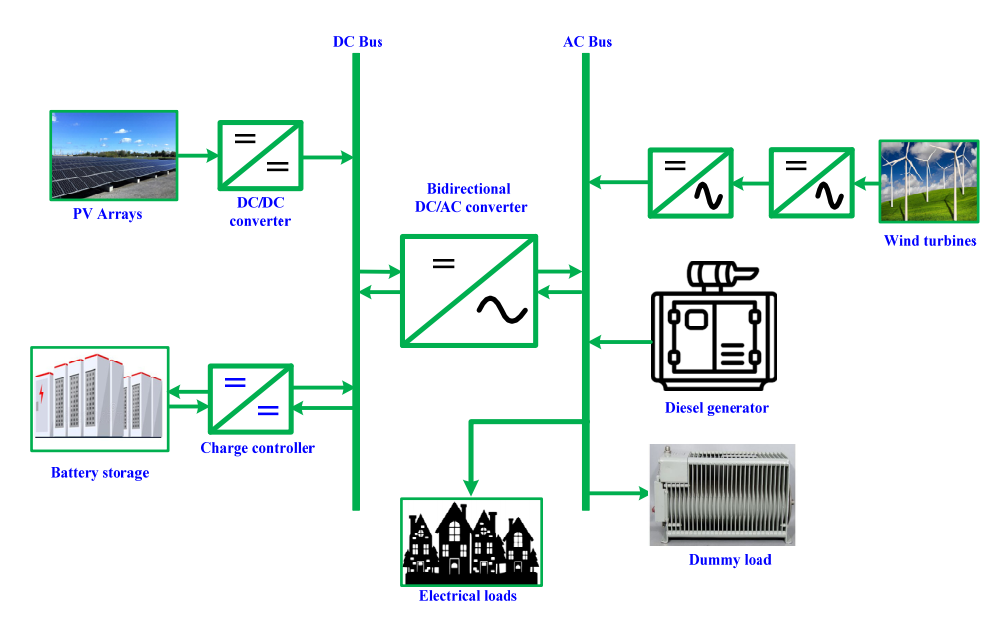

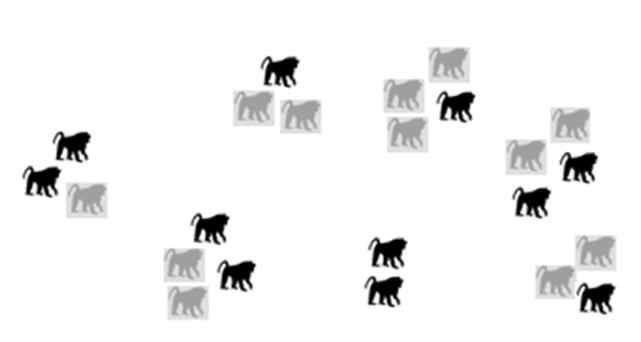

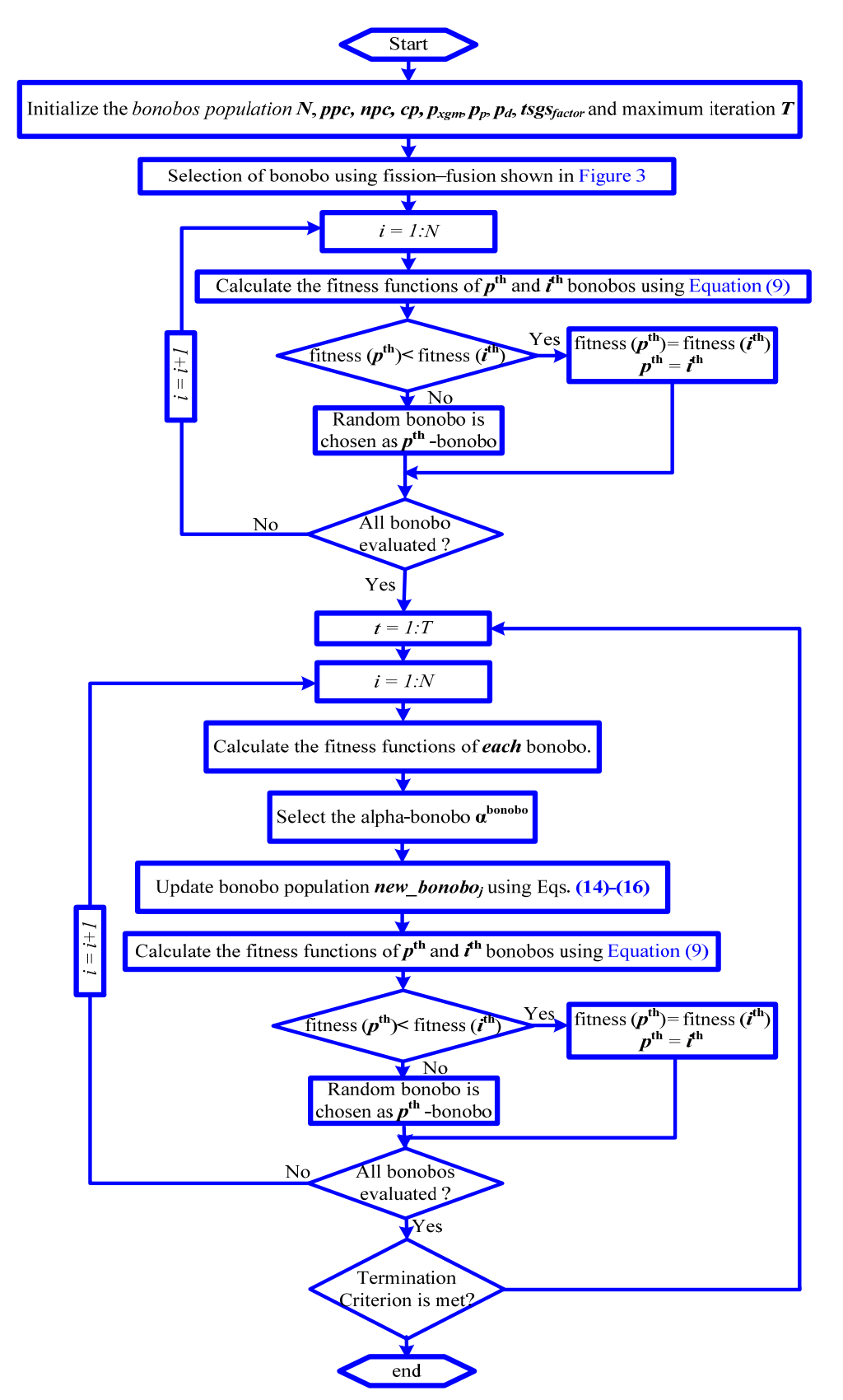




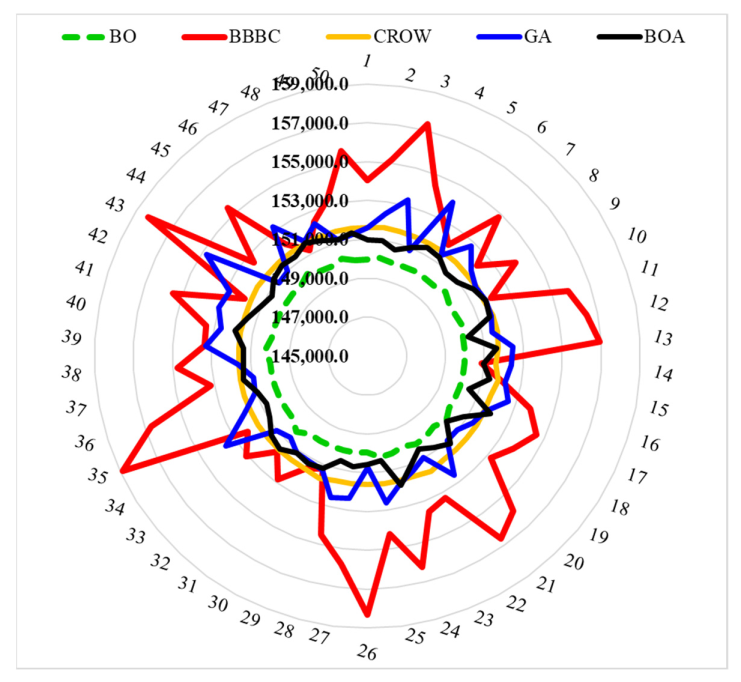
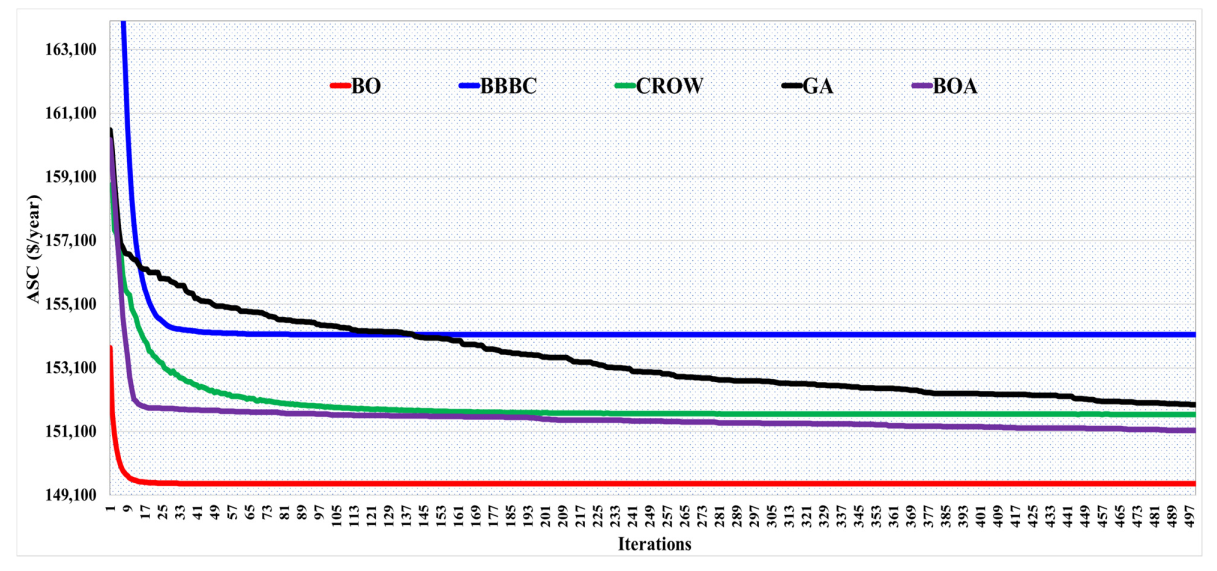
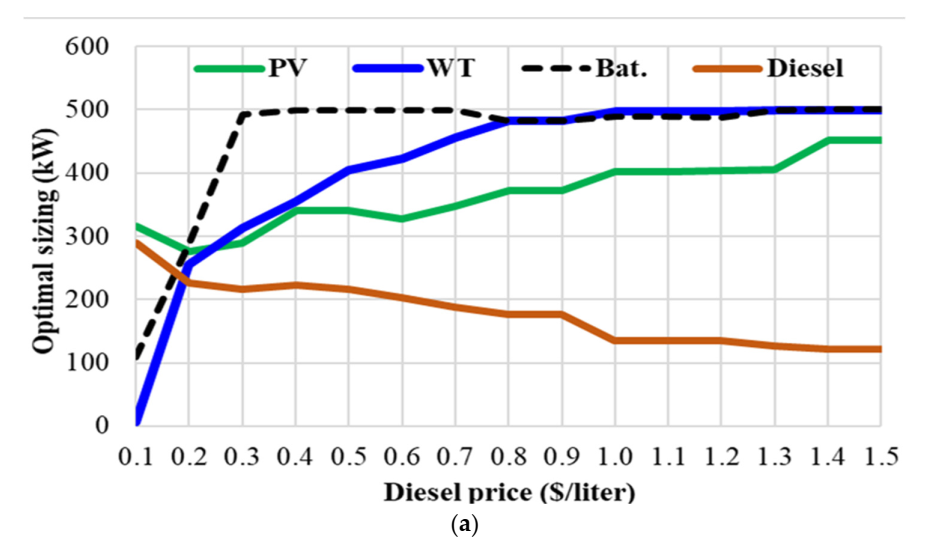

| Algorithm | Main Parameters | Value |
|---|---|---|
| BO | Rate of change in phase probability | 0.0035 |
| Sharing coefficient for selected bonobo | 1.3 | |
| Sharing coefficient for alpha bonobo | 1.25 | |
| Extra-group mating probability | 0.001 | |
| BBBC | Energy of rabbit | 2 |
| Population size | 100 | |
| Crow search | Awareness probability | 0.1 |
| Flight length | 2 | |
| GA | Population | 100 |
| Selection | Roulette wheel | |
| Mutation rate | 0.2 | |
| Crossover rate | 0.8 | |
| BOA | Sensory modality | 0.01 |
| Power exponent | 0.1 |
| Algorithm | Performance Indicators | PPV (kW) | PWT (kW) | PBat. (kW) | PDiesl (kW) | ASC (USD/year) | REF (%) |
|---|---|---|---|---|---|---|---|
| BO | Optimal | 341.3 | 403.9 | 499.8 | 215.9 | 149,977.2 | 82.7 |
| Worst | 342 | 353.7 | 500 | 220.12 | 150,320.8 | 81.04 | |
| Mean | 340.62 | 400.36 | 499.83 | 215.84 | 150,033.1 | 82.61 | |
| STDEV | 5.97 | 12.75 | 0.2996 | 2.894 | 95.397 | 0.4021 | |
| BBBC | Optimal | 397.85 | 348.4 | 923.9 | 229.1 | 150,883.5 | 64.55 |
| Worst | 293.95 | 434.95 | 1436.3 | 248.06 | 158,884.5 | 70.52 | |
| Mean | 372.75 | 364.27 | 844.21 | 239.71 | 154,138.5 | 86.67 | |
| STDEV | 72.14 | 69.41 | 293.67 | 7.45 | 2007.99 | 10.379 | |
| Crow Search | Optimal | 341.3 | 403.98 | 499.22 | 215.93 | 151,618.8 | 82.74 |
| Worst | 358.7 | 405.75 | 498.86 | 221.74 | 151,832.6 | 83.046 | |
| Mean | 341.84 | 405.04 | 499.11 | 216 | 151,640.4 | 82.774 | |
| STDEV | 4.568 | 2.931 | 0.3925 | 0.8840 | 50.772 | 0.0984 | |
| GA | Optimal | 370.21 | 311.51 | 1027.5 | 210.8 | 150,718 | 85.22 |
| Worst | 496.29 | 260.45 | 1355.8 | 204.24 | 154,770 | 88.27 | |
| Mean | 375.56 | 346.95 | 940.64 | 219.09 | 151,944.6 | 85.55 | |
| STDEV | 45.92 | 52.921 | 161.35 | 21.43 | 927.45 | 1.6267 | |
| Optimal | 361.28 | 373.70 | 950.01 | 227.34 | 150,236.4 | 63.32 | |
| Worst | 352.07 | 331.31 | 657.54 | 228.07 | 151,968.8 | 61.28 | |
| BOA | Mean | 343.87 | 353.63 | 850.27 | 214.06 | 151,130.5 | 66.93 |
| STDEV | 26.359 | 27.982 | 161.531 | 11.461 | 422.106 | 6.2367 |
| Diesel Price (USD/Liter) | PV | WT | Bat. | Diesel | REF | Surplus | Diesel Hours | Fuel cost (USD/yr) | CO2 (kg/yr) | ASC (USD/yr) |
|---|---|---|---|---|---|---|---|---|---|---|
| 0.1 | 315.7 | 7.1 | 109.5 | 289.3 | 43.1 | 6.6 | 6021.0 | 30,660.6 | 454,729.3 | 98,185.6 |
| 0.2 | 275.9 | 255.7 | 287.1 | 226.6 | 71.6 | 11.0 | 3520.0 | 29,593.7 | 229,691.9 | 116,353.0 |
| 0.3 | 288.8 | 312.6 | 493.1 | 215.8 | 77.8 | 68.9 | 2669.0 | 33,386.3 | 178,479.0 | 129,834.4 |
| 0.4 | 341.0 | 354.9 | 499.8 | 222.8 | 81.0 | 54.9 | 2242.0 | 38,296.3 | 152,589.4 | 140,686.4 |
| 0.5 | 341.3 | 403.9 | 499.8 | 215.9 | 82.7 | 3.5 | 2020.0 | 42,722.8 | 138,529.7 | 149,977.2 |
| 0.6 | 327.8 | 422.3 | 499.8 | 202.2 | 83.1 | 20.3 | 1992.0 | 48,897.7 | 135,260.3 | 158,364.8 |
| 0.7 | 347.3 | 455.7 | 499.5 | 187.7 | 84.5 | 56.3 | 1844.0 | 50,872.3 | 123,745.5 | 166,060.2 |
| 0.8 | 372.6 | 482.5 | 482.0 | 176.1 | 85.5 | 15.7 | 1724.0 | 52,893.3 | 115,260.1 | 173,061.2 |
| 0.9 | 372.6 | 482.5 | 482.0 | 176.1 | 85.5 | 17.8 | 1724.0 | 59,505.0 | 115,260.1 | 179,672.8 |
| 1.0 | 402.8 | 496.8 | 489.2 | 134.7 | 87.1 | 16.2 | 1659.0 | 54,689.9 | 101,971.3 | 185,830.4 |
| 1.1 | 402.5 | 496.9 | 489.0 | 134.7 | 87.1 | 55.9 | 1660.0 | 60,189.7 | 102,002.2 | 191,319.3 |
| 1.2 | 403.1 | 497.7 | 487.3 | 134.5 | 87.1 | 21.7 | 1657.0 | 65,512.1 | 101,843.4 | 196,821.0 |
| 1.3 | 404.9 | 498.9 | 499.8 | 126.6 | 87.5 | 64.2 | 1634.0 | 67,803.4 | 98,737.1 | 202,402.6 |
| 1.4 | 451.4 | 499.7 | 500.0 | 121.4 | 88.1 | 2.5 | 1583.0 | 69,060.1 | 94,232.8 | 207,520.9 |
| 1.5 | 451.4 | 499.7 | 500.0 | 121.4 | 88.1 | 88.3 | 1583.0 | 73,992.8 | 94,232.7 | 212,453.8 |
Publisher’s Note: MDPI stays neutral with regard to jurisdictional claims in published maps and institutional affiliations. |
© 2022 by the authors. Licensee MDPI, Basel, Switzerland. This article is an open access article distributed under the terms and conditions of the Creative Commons Attribution (CC BY) license (https://creativecommons.org/licenses/by/4.0/).
Share and Cite
Farh, H.M.H.; Al-Shamma’a, A.A.; Al-Shaalan, A.M.; Alkuhayli, A.; Noman, A.M.; Kandil, T. Technical and Economic Evaluation for Off-Grid Hybrid Renewable Energy System Using Novel Bonobo Optimizer. Sustainability 2022, 14, 1533. https://doi.org/10.3390/su14031533
Farh HMH, Al-Shamma’a AA, Al-Shaalan AM, Alkuhayli A, Noman AM, Kandil T. Technical and Economic Evaluation for Off-Grid Hybrid Renewable Energy System Using Novel Bonobo Optimizer. Sustainability. 2022; 14(3):1533. https://doi.org/10.3390/su14031533
Chicago/Turabian StyleFarh, Hassan M. H., Abdullrahman A. Al-Shamma’a, Abdullah M. Al-Shaalan, Abdulaziz Alkuhayli, Abdullah M. Noman, and Tarek Kandil. 2022. "Technical and Economic Evaluation for Off-Grid Hybrid Renewable Energy System Using Novel Bonobo Optimizer" Sustainability 14, no. 3: 1533. https://doi.org/10.3390/su14031533







